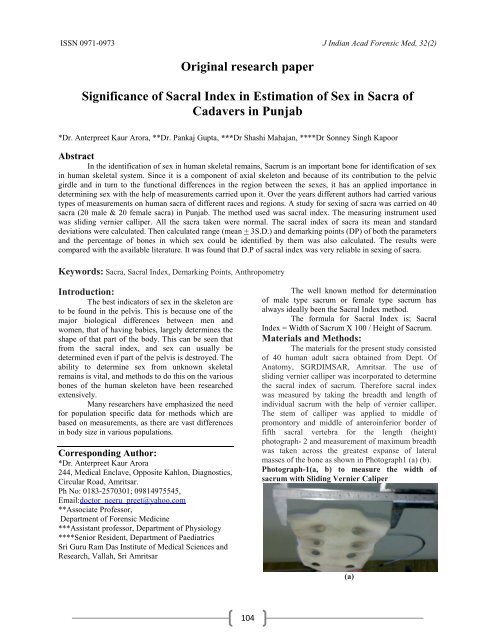jiafm, 2010-32(2) april-june. - forensic medicine
jiafm, 2010-32(2) april-june. - forensic medicine
jiafm, 2010-32(2) april-june. - forensic medicine
- No tags were found...
You also want an ePaper? Increase the reach of your titles
YUMPU automatically turns print PDFs into web optimized ePapers that Google loves.
ISSN 0971-0973 J Indian Acad Forensic Med, <strong>32</strong>(2)Original research paperSignificance of Sacral Index in Estimation of Sex in Sacra ofCadavers in Punjab*Dr. Anterpreet Kaur Arora, **Dr. Pankaj Gupta, ***Dr Shashi Mahajan, ****Dr Sonney Singh KapoorAbstractIn the identification of sex in human skeletal remains, Sacrum is an important bone for identification of sexin human skeletal system. Since it is a component of axial skeleton and because of its contribution to the pelvicgirdle and in turn to the functional differences in the region between the sexes, it has an applied importance indetermining sex with the help of measurements carried upon it. Over the years different authors had carried varioustypes of measurements on human sacra of different races and regions. A study for sexing of sacra was carried on 40sacra (20 male & 20 female sacra) in Punjab. The method used was sacral index. The measuring instrument usedwas sliding vernier calliper. All the sacra taken were normal. The sacral index of sacra its mean and standarddeviations were calculated. Then calculated range (mean + 3S.D.) and demarking points (DP) of both the parametersand the percentage of bones in which sex could be identified by them was also calculated. The results werecompared with the available literature. It was found that D.P of sacral index was very reliable in sexing of sacra.Keywords: Sacra, Sacral Index, Demarking Points, AnthropometryIntroduction:The best indicators of sex in the skeleton areto be found in the pelvis. This is because one of themajor biological differences between men andwomen, that of having babies, largely determines theshape of that part of the body. This can be seen thatfrom the sacral index, and sex can usually bedetermined even if part of the pelvis is destroyed. Theability to determine sex from unknown skeletalremains is vital, and methods to do this on the variousbones of the human skeleton have been researchedextensively.Many researchers have emphasized the needfor population specific data for methods which arebased on measurements, as there are vast differencesin body size in various populations.Corresponding Author:*Dr. Anterpreet Kaur Arora244, Medical Enclave, Opposite Kahlon, Diagnostics,Circular Road, Amritsar.Ph No: 0183-2570301; 09814975545,Email:doctor_neeru_preet@yahoo.com**Associate Professor,Department of Forensic Medicine***Assistant professor, Department of Physiology****Senior Resident, Department of PaediatricsSri Guru Ram Das Institute of Medical Sciences andResearch, Vallah, Sri AmritsarThe well known method for determinationof male type sacrum or female type sacrum hasalways ideally been the Sacral Index method.The formula for Sacral Index is; SacralIndex = Width of Sacrum X 100 / Height of Sacrum.Materials and Methods:The materials for the present study consistedof 40 human adult sacra obtained from Dept. OfAnatomy, SGRDIMSAR, Amritsar. The use ofsliding vernier calliper was incorporated to determinethe sacral index of sacrum. Therefore sacral indexwas measured by taking the breadth and length ofindividual sacrum with the help of vernier calliper.The stem of calliper was applied to middle ofpromontory and middle of anteroinferior border offifth sacral vertebra for the length (height)photograph- 2 and measurement of maximum breadthwas taken across the greatest expanse of lateralmasses of the bone as shown in Photograph1 (a) (b).Photograph-1(a, b) to measure the width ofsacrum with Sliding Vernier Caliper(a)104



![syllabus in forensic medicine for m.b.b.s. students in india [pdf]](https://img.yumpu.com/48405011/1/190x245/syllabus-in-forensic-medicine-for-mbbs-students-in-india-pdf.jpg?quality=85)



![SPOTTING IN FORENSIC MEDICINE [pdf]](https://img.yumpu.com/45856557/1/190x245/spotting-in-forensic-medicine-pdf.jpg?quality=85)

![JAFM-33-2, April-June, 2011 [PDF] - forensic medicine](https://img.yumpu.com/43461356/1/190x245/jafm-33-2-april-june-2011-pdf-forensic-medicine.jpg?quality=85)



![JIAFM-33-4, October-December, 2011 [PDF] - forensic medicine](https://img.yumpu.com/31013278/1/190x245/jiafm-33-4-october-december-2011-pdf-forensic-medicine.jpg?quality=85)


